CSR Initiatives: Nissan Motors Corporation Analysis, Report
VerifiedAdded on 2020/05/28
|18
|3593
|56
Report
AI Summary
This report provides a comprehensive analysis of Nissan Motor Corporation's Corporate Social Responsibility (CSR) initiatives. It begins with an executive summary and an introduction to CSR, outlining its characteristics and various approaches, including economic, legal, value creation, and stakeholder theories. The report then delves into Nissan's specific CSR activities, categorizing them under environment, safety, philanthropy, quality, and employee relations. The discussion on environment highlights Nissan's commitment to reducing carbon footprint and promoting zero-emission vehicles. The section on safety emphasizes Nissan's efforts to enhance vehicle safety through automated driver support technologies. The report also touches upon Nissan's philanthropic endeavors, focus on quality, and employee-related initiatives. The report concludes with recommendations for further CSR improvements and references relevant sources.
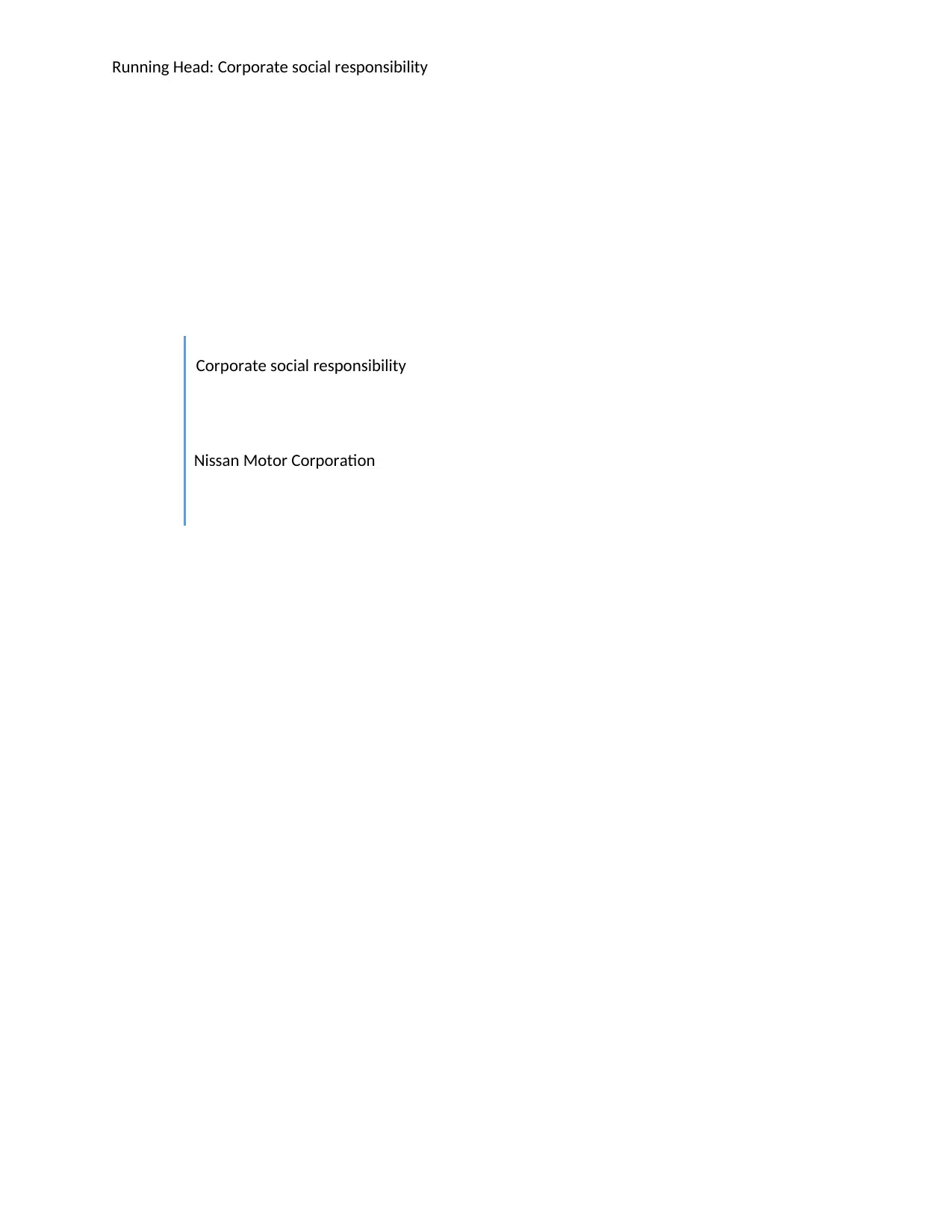
Running Head: Corporate social responsibility
Corporate social responsibility
Nissan Motor Corporation
Corporate social responsibility
Nissan Motor Corporation
Paraphrase This Document
Need a fresh take? Get an instant paraphrase of this document with our AI Paraphraser
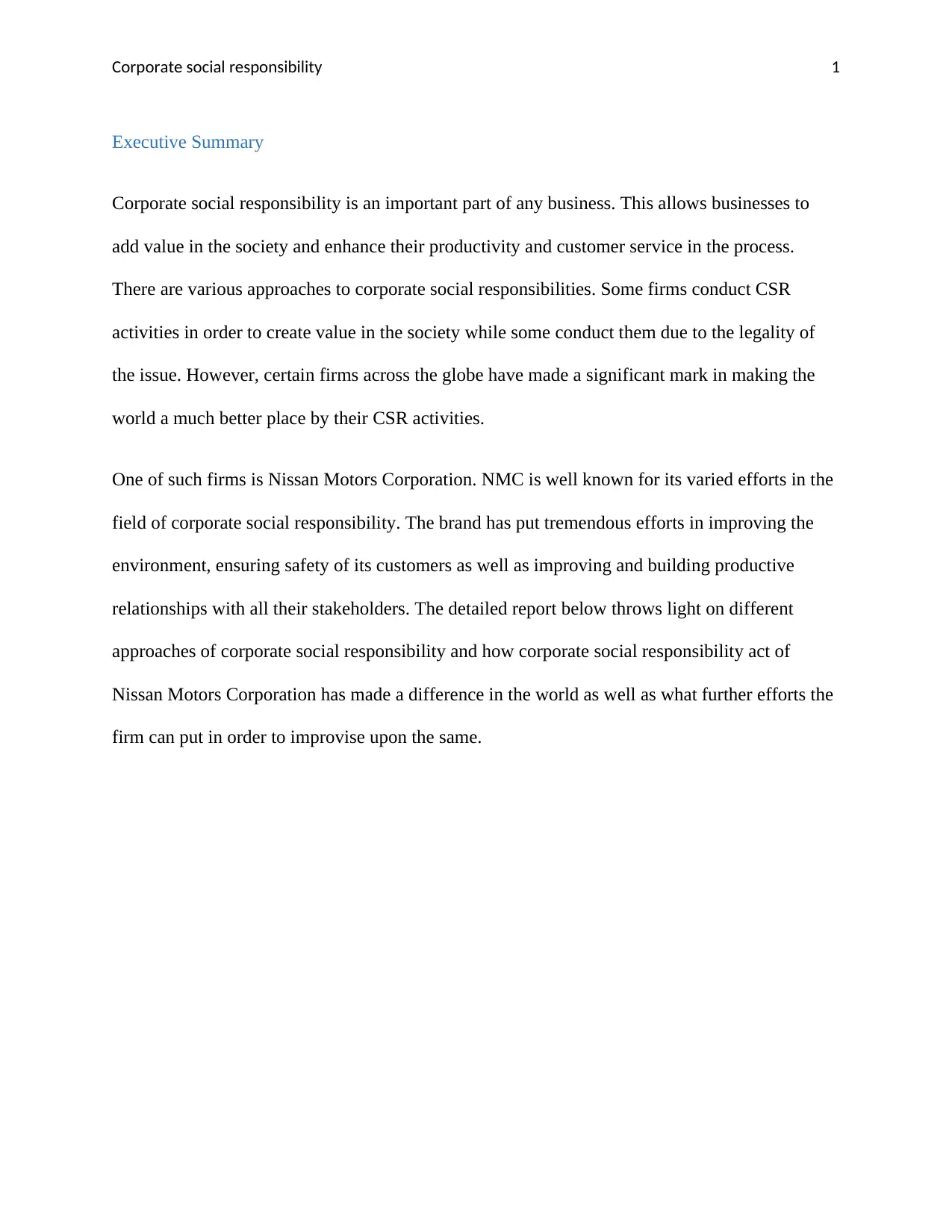
Corporate social responsibility 1
Executive Summary
Corporate social responsibility is an important part of any business. This allows businesses to
add value in the society and enhance their productivity and customer service in the process.
There are various approaches to corporate social responsibilities. Some firms conduct CSR
activities in order to create value in the society while some conduct them due to the legality of
the issue. However, certain firms across the globe have made a significant mark in making the
world a much better place by their CSR activities.
One of such firms is Nissan Motors Corporation. NMC is well known for its varied efforts in the
field of corporate social responsibility. The brand has put tremendous efforts in improving the
environment, ensuring safety of its customers as well as improving and building productive
relationships with all their stakeholders. The detailed report below throws light on different
approaches of corporate social responsibility and how corporate social responsibility act of
Nissan Motors Corporation has made a difference in the world as well as what further efforts the
firm can put in order to improvise upon the same.
Executive Summary
Corporate social responsibility is an important part of any business. This allows businesses to
add value in the society and enhance their productivity and customer service in the process.
There are various approaches to corporate social responsibilities. Some firms conduct CSR
activities in order to create value in the society while some conduct them due to the legality of
the issue. However, certain firms across the globe have made a significant mark in making the
world a much better place by their CSR activities.
One of such firms is Nissan Motors Corporation. NMC is well known for its varied efforts in the
field of corporate social responsibility. The brand has put tremendous efforts in improving the
environment, ensuring safety of its customers as well as improving and building productive
relationships with all their stakeholders. The detailed report below throws light on different
approaches of corporate social responsibility and how corporate social responsibility act of
Nissan Motors Corporation has made a difference in the world as well as what further efforts the
firm can put in order to improvise upon the same.
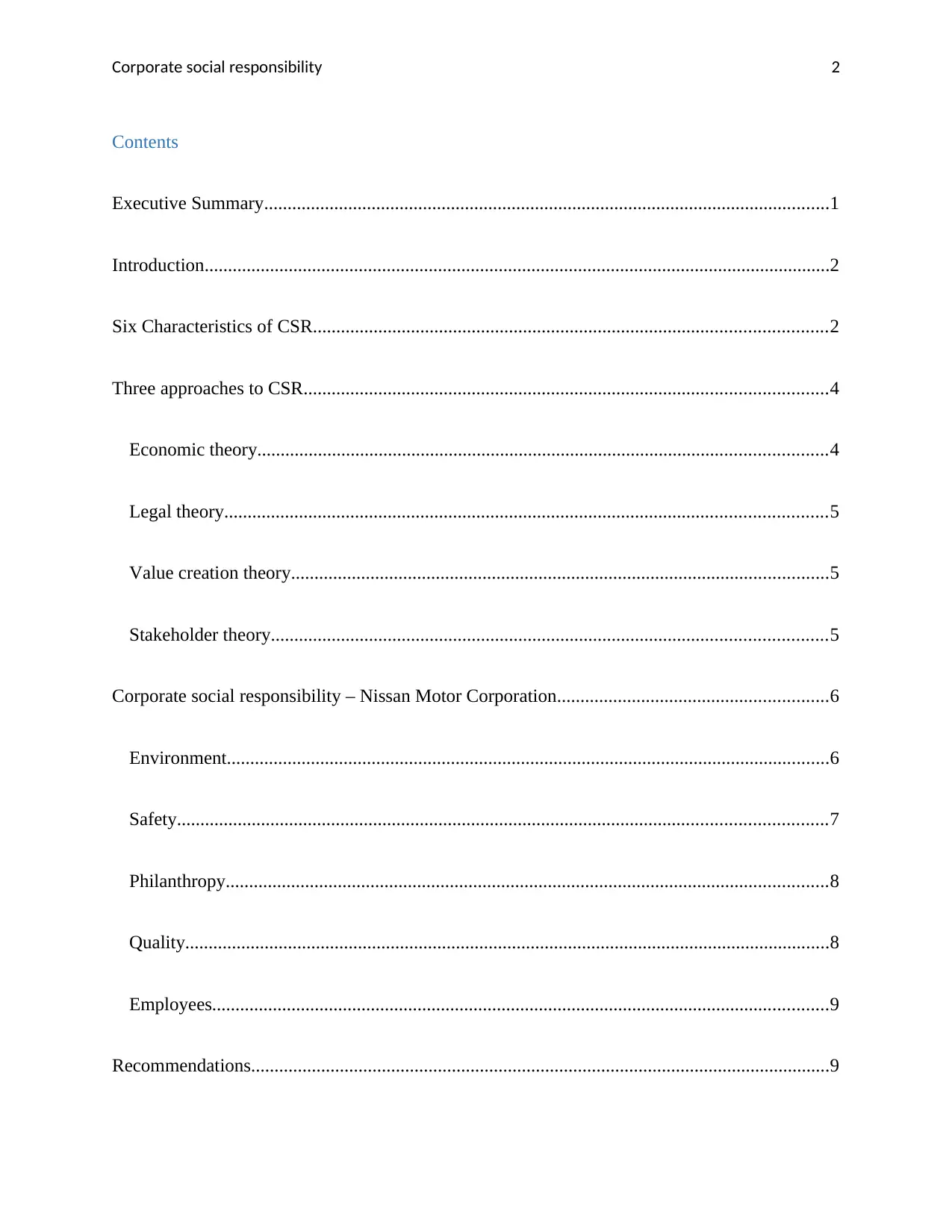
Corporate social responsibility 2
Contents
Executive Summary.........................................................................................................................1
Introduction......................................................................................................................................2
Six Characteristics of CSR..............................................................................................................2
Three approaches to CSR................................................................................................................4
Economic theory..........................................................................................................................4
Legal theory.................................................................................................................................5
Value creation theory...................................................................................................................5
Stakeholder theory.......................................................................................................................5
Corporate social responsibility – Nissan Motor Corporation..........................................................6
Environment.................................................................................................................................6
Safety...........................................................................................................................................7
Philanthropy.................................................................................................................................8
Quality..........................................................................................................................................8
Employees....................................................................................................................................9
Recommendations............................................................................................................................9
Contents
Executive Summary.........................................................................................................................1
Introduction......................................................................................................................................2
Six Characteristics of CSR..............................................................................................................2
Three approaches to CSR................................................................................................................4
Economic theory..........................................................................................................................4
Legal theory.................................................................................................................................5
Value creation theory...................................................................................................................5
Stakeholder theory.......................................................................................................................5
Corporate social responsibility – Nissan Motor Corporation..........................................................6
Environment.................................................................................................................................6
Safety...........................................................................................................................................7
Philanthropy.................................................................................................................................8
Quality..........................................................................................................................................8
Employees....................................................................................................................................9
Recommendations............................................................................................................................9
⊘ This is a preview!⊘
Do you want full access?
Subscribe today to unlock all pages.

Trusted by 1+ million students worldwide

Corporate social responsibility 3
Ecological responsibilities...........................................................................................................9
Social welfare.............................................................................................................................10
Employee responsibilities..........................................................................................................10
Conclusion.....................................................................................................................................10
References......................................................................................................................................12
Ecological responsibilities...........................................................................................................9
Social welfare.............................................................................................................................10
Employee responsibilities..........................................................................................................10
Conclusion.....................................................................................................................................10
References......................................................................................................................................12
Paraphrase This Document
Need a fresh take? Get an instant paraphrase of this document with our AI Paraphraser
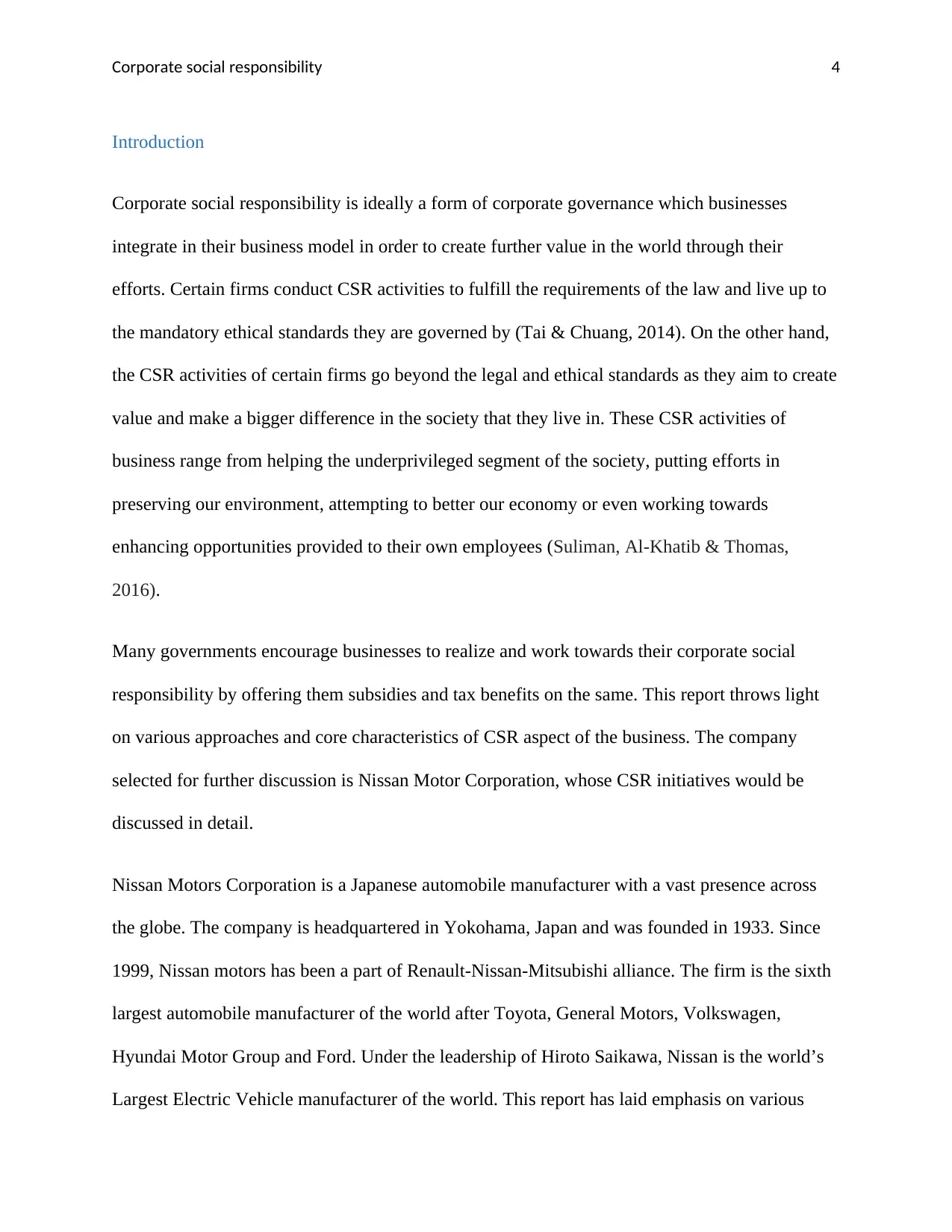
Corporate social responsibility 4
Introduction
Corporate social responsibility is ideally a form of corporate governance which businesses
integrate in their business model in order to create further value in the world through their
efforts. Certain firms conduct CSR activities to fulfill the requirements of the law and live up to
the mandatory ethical standards they are governed by (Tai & Chuang, 2014). On the other hand,
the CSR activities of certain firms go beyond the legal and ethical standards as they aim to create
value and make a bigger difference in the society that they live in. These CSR activities of
business range from helping the underprivileged segment of the society, putting efforts in
preserving our environment, attempting to better our economy or even working towards
enhancing opportunities provided to their own employees (Suliman, Al-Khatib & Thomas,
2016).
Many governments encourage businesses to realize and work towards their corporate social
responsibility by offering them subsidies and tax benefits on the same. This report throws light
on various approaches and core characteristics of CSR aspect of the business. The company
selected for further discussion is Nissan Motor Corporation, whose CSR initiatives would be
discussed in detail.
Nissan Motors Corporation is a Japanese automobile manufacturer with a vast presence across
the globe. The company is headquartered in Yokohama, Japan and was founded in 1933. Since
1999, Nissan motors has been a part of Renault-Nissan-Mitsubishi alliance. The firm is the sixth
largest automobile manufacturer of the world after Toyota, General Motors, Volkswagen,
Hyundai Motor Group and Ford. Under the leadership of Hiroto Saikawa, Nissan is the world’s
Largest Electric Vehicle manufacturer of the world. This report has laid emphasis on various
Introduction
Corporate social responsibility is ideally a form of corporate governance which businesses
integrate in their business model in order to create further value in the world through their
efforts. Certain firms conduct CSR activities to fulfill the requirements of the law and live up to
the mandatory ethical standards they are governed by (Tai & Chuang, 2014). On the other hand,
the CSR activities of certain firms go beyond the legal and ethical standards as they aim to create
value and make a bigger difference in the society that they live in. These CSR activities of
business range from helping the underprivileged segment of the society, putting efforts in
preserving our environment, attempting to better our economy or even working towards
enhancing opportunities provided to their own employees (Suliman, Al-Khatib & Thomas,
2016).
Many governments encourage businesses to realize and work towards their corporate social
responsibility by offering them subsidies and tax benefits on the same. This report throws light
on various approaches and core characteristics of CSR aspect of the business. The company
selected for further discussion is Nissan Motor Corporation, whose CSR initiatives would be
discussed in detail.
Nissan Motors Corporation is a Japanese automobile manufacturer with a vast presence across
the globe. The company is headquartered in Yokohama, Japan and was founded in 1933. Since
1999, Nissan motors has been a part of Renault-Nissan-Mitsubishi alliance. The firm is the sixth
largest automobile manufacturer of the world after Toyota, General Motors, Volkswagen,
Hyundai Motor Group and Ford. Under the leadership of Hiroto Saikawa, Nissan is the world’s
Largest Electric Vehicle manufacturer of the world. This report has laid emphasis on various
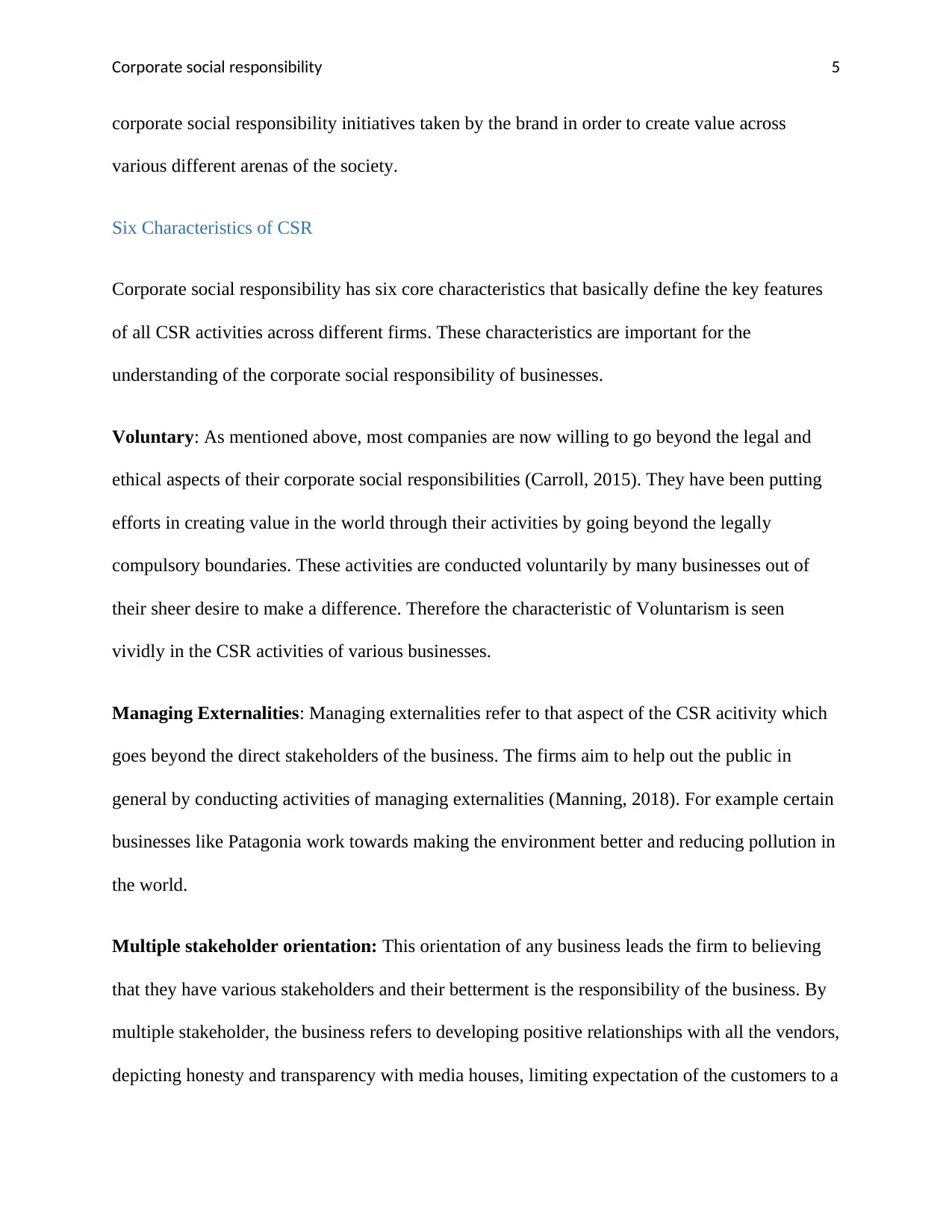
Corporate social responsibility 5
corporate social responsibility initiatives taken by the brand in order to create value across
various different arenas of the society.
Six Characteristics of CSR
Corporate social responsibility has six core characteristics that basically define the key features
of all CSR activities across different firms. These characteristics are important for the
understanding of the corporate social responsibility of businesses.
Voluntary: As mentioned above, most companies are now willing to go beyond the legal and
ethical aspects of their corporate social responsibilities (Carroll, 2015). They have been putting
efforts in creating value in the world through their activities by going beyond the legally
compulsory boundaries. These activities are conducted voluntarily by many businesses out of
their sheer desire to make a difference. Therefore the characteristic of Voluntarism is seen
vividly in the CSR activities of various businesses.
Managing Externalities: Managing externalities refer to that aspect of the CSR acitivity which
goes beyond the direct stakeholders of the business. The firms aim to help out the public in
general by conducting activities of managing externalities (Manning, 2018). For example certain
businesses like Patagonia work towards making the environment better and reducing pollution in
the world.
Multiple stakeholder orientation: This orientation of any business leads the firm to believing
that they have various stakeholders and their betterment is the responsibility of the business. By
multiple stakeholder, the business refers to developing positive relationships with all the vendors,
depicting honesty and transparency with media houses, limiting expectation of the customers to a
corporate social responsibility initiatives taken by the brand in order to create value across
various different arenas of the society.
Six Characteristics of CSR
Corporate social responsibility has six core characteristics that basically define the key features
of all CSR activities across different firms. These characteristics are important for the
understanding of the corporate social responsibility of businesses.
Voluntary: As mentioned above, most companies are now willing to go beyond the legal and
ethical aspects of their corporate social responsibilities (Carroll, 2015). They have been putting
efforts in creating value in the world through their activities by going beyond the legally
compulsory boundaries. These activities are conducted voluntarily by many businesses out of
their sheer desire to make a difference. Therefore the characteristic of Voluntarism is seen
vividly in the CSR activities of various businesses.
Managing Externalities: Managing externalities refer to that aspect of the CSR acitivity which
goes beyond the direct stakeholders of the business. The firms aim to help out the public in
general by conducting activities of managing externalities (Manning, 2018). For example certain
businesses like Patagonia work towards making the environment better and reducing pollution in
the world.
Multiple stakeholder orientation: This orientation of any business leads the firm to believing
that they have various stakeholders and their betterment is the responsibility of the business. By
multiple stakeholder, the business refers to developing positive relationships with all the vendors,
depicting honesty and transparency with media houses, limiting expectation of the customers to a
⊘ This is a preview!⊘
Do you want full access?
Subscribe today to unlock all pages.

Trusted by 1+ million students worldwide
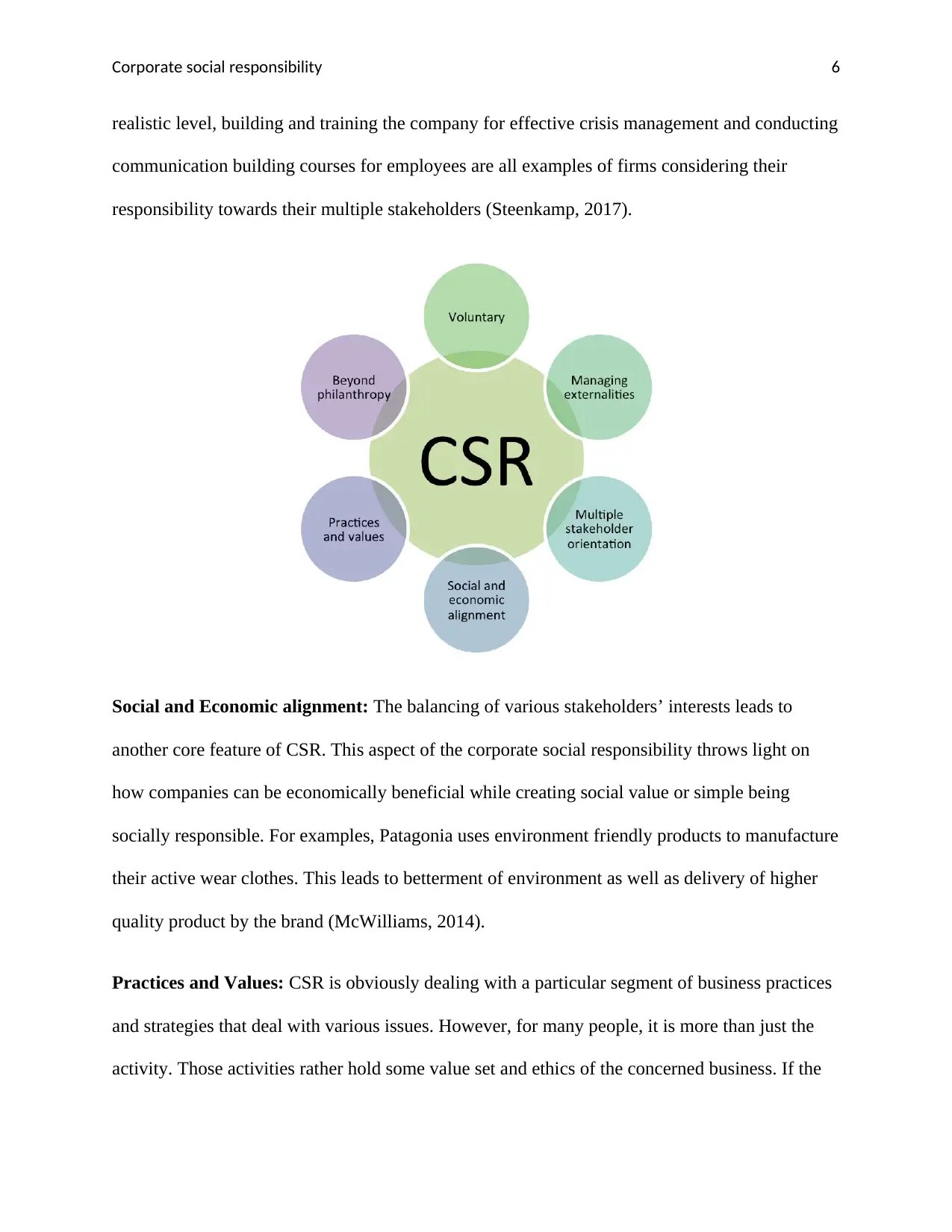
Corporate social responsibility 6
realistic level, building and training the company for effective crisis management and conducting
communication building courses for employees are all examples of firms considering their
responsibility towards their multiple stakeholders (Steenkamp, 2017).
Social and Economic alignment: The balancing of various stakeholders’ interests leads to
another core feature of CSR. This aspect of the corporate social responsibility throws light on
how companies can be economically beneficial while creating social value or simple being
socially responsible. For examples, Patagonia uses environment friendly products to manufacture
their active wear clothes. This leads to betterment of environment as well as delivery of higher
quality product by the brand (McWilliams, 2014).
Practices and Values: CSR is obviously dealing with a particular segment of business practices
and strategies that deal with various issues. However, for many people, it is more than just the
activity. Those activities rather hold some value set and ethics of the concerned business. If the
realistic level, building and training the company for effective crisis management and conducting
communication building courses for employees are all examples of firms considering their
responsibility towards their multiple stakeholders (Steenkamp, 2017).
Social and Economic alignment: The balancing of various stakeholders’ interests leads to
another core feature of CSR. This aspect of the corporate social responsibility throws light on
how companies can be economically beneficial while creating social value or simple being
socially responsible. For examples, Patagonia uses environment friendly products to manufacture
their active wear clothes. This leads to betterment of environment as well as delivery of higher
quality product by the brand (McWilliams, 2014).
Practices and Values: CSR is obviously dealing with a particular segment of business practices
and strategies that deal with various issues. However, for many people, it is more than just the
activity. Those activities rather hold some value set and ethics of the concerned business. If the
Paraphrase This Document
Need a fresh take? Get an instant paraphrase of this document with our AI Paraphraser
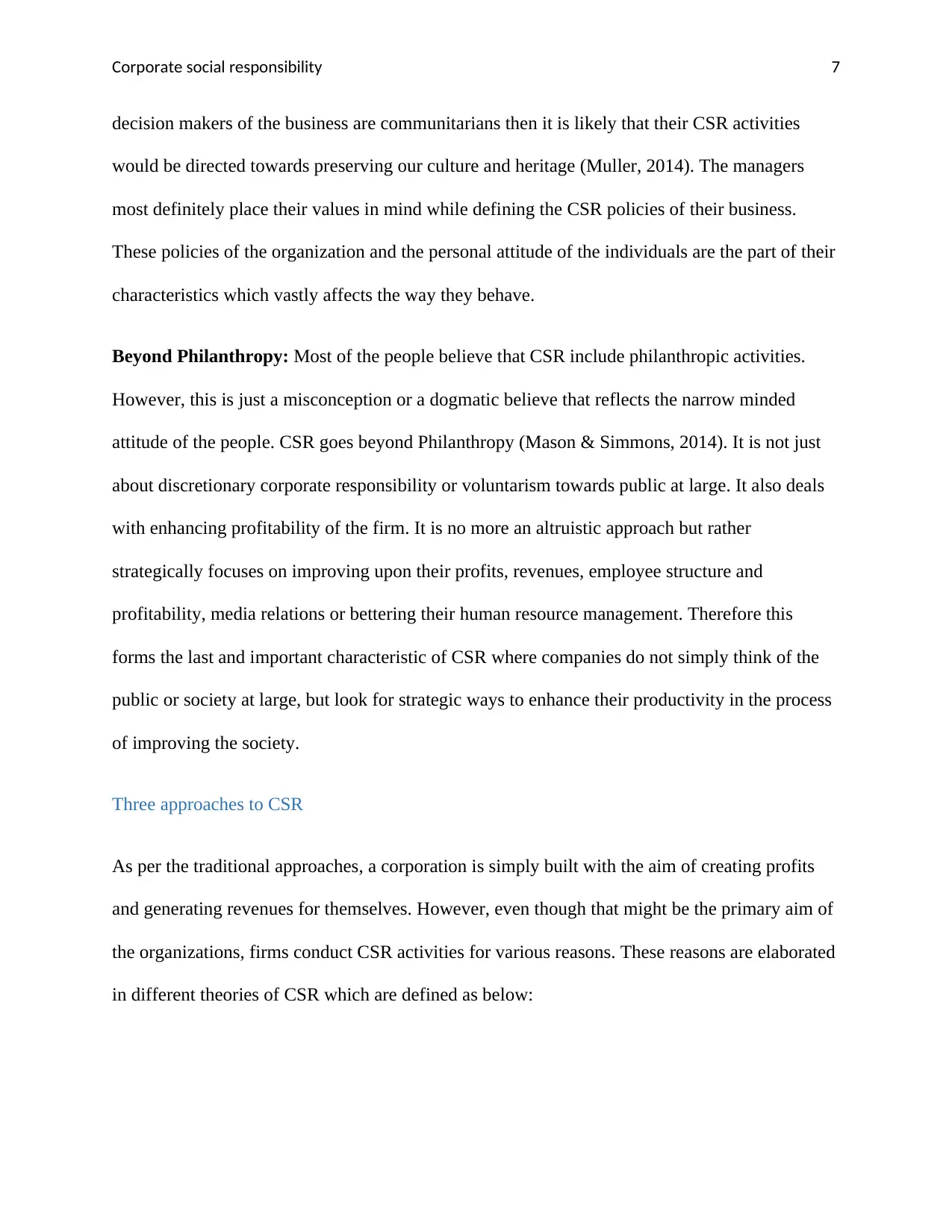
Corporate social responsibility 7
decision makers of the business are communitarians then it is likely that their CSR activities
would be directed towards preserving our culture and heritage (Muller, 2014). The managers
most definitely place their values in mind while defining the CSR policies of their business.
These policies of the organization and the personal attitude of the individuals are the part of their
characteristics which vastly affects the way they behave.
Beyond Philanthropy: Most of the people believe that CSR include philanthropic activities.
However, this is just a misconception or a dogmatic believe that reflects the narrow minded
attitude of the people. CSR goes beyond Philanthropy (Mason & Simmons, 2014). It is not just
about discretionary corporate responsibility or voluntarism towards public at large. It also deals
with enhancing profitability of the firm. It is no more an altruistic approach but rather
strategically focuses on improving upon their profits, revenues, employee structure and
profitability, media relations or bettering their human resource management. Therefore this
forms the last and important characteristic of CSR where companies do not simply think of the
public or society at large, but look for strategic ways to enhance their productivity in the process
of improving the society.
Three approaches to CSR
As per the traditional approaches, a corporation is simply built with the aim of creating profits
and generating revenues for themselves. However, even though that might be the primary aim of
the organizations, firms conduct CSR activities for various reasons. These reasons are elaborated
in different theories of CSR which are defined as below:
decision makers of the business are communitarians then it is likely that their CSR activities
would be directed towards preserving our culture and heritage (Muller, 2014). The managers
most definitely place their values in mind while defining the CSR policies of their business.
These policies of the organization and the personal attitude of the individuals are the part of their
characteristics which vastly affects the way they behave.
Beyond Philanthropy: Most of the people believe that CSR include philanthropic activities.
However, this is just a misconception or a dogmatic believe that reflects the narrow minded
attitude of the people. CSR goes beyond Philanthropy (Mason & Simmons, 2014). It is not just
about discretionary corporate responsibility or voluntarism towards public at large. It also deals
with enhancing profitability of the firm. It is no more an altruistic approach but rather
strategically focuses on improving upon their profits, revenues, employee structure and
profitability, media relations or bettering their human resource management. Therefore this
forms the last and important characteristic of CSR where companies do not simply think of the
public or society at large, but look for strategic ways to enhance their productivity in the process
of improving the society.
Three approaches to CSR
As per the traditional approaches, a corporation is simply built with the aim of creating profits
and generating revenues for themselves. However, even though that might be the primary aim of
the organizations, firms conduct CSR activities for various reasons. These reasons are elaborated
in different theories of CSR which are defined as below:
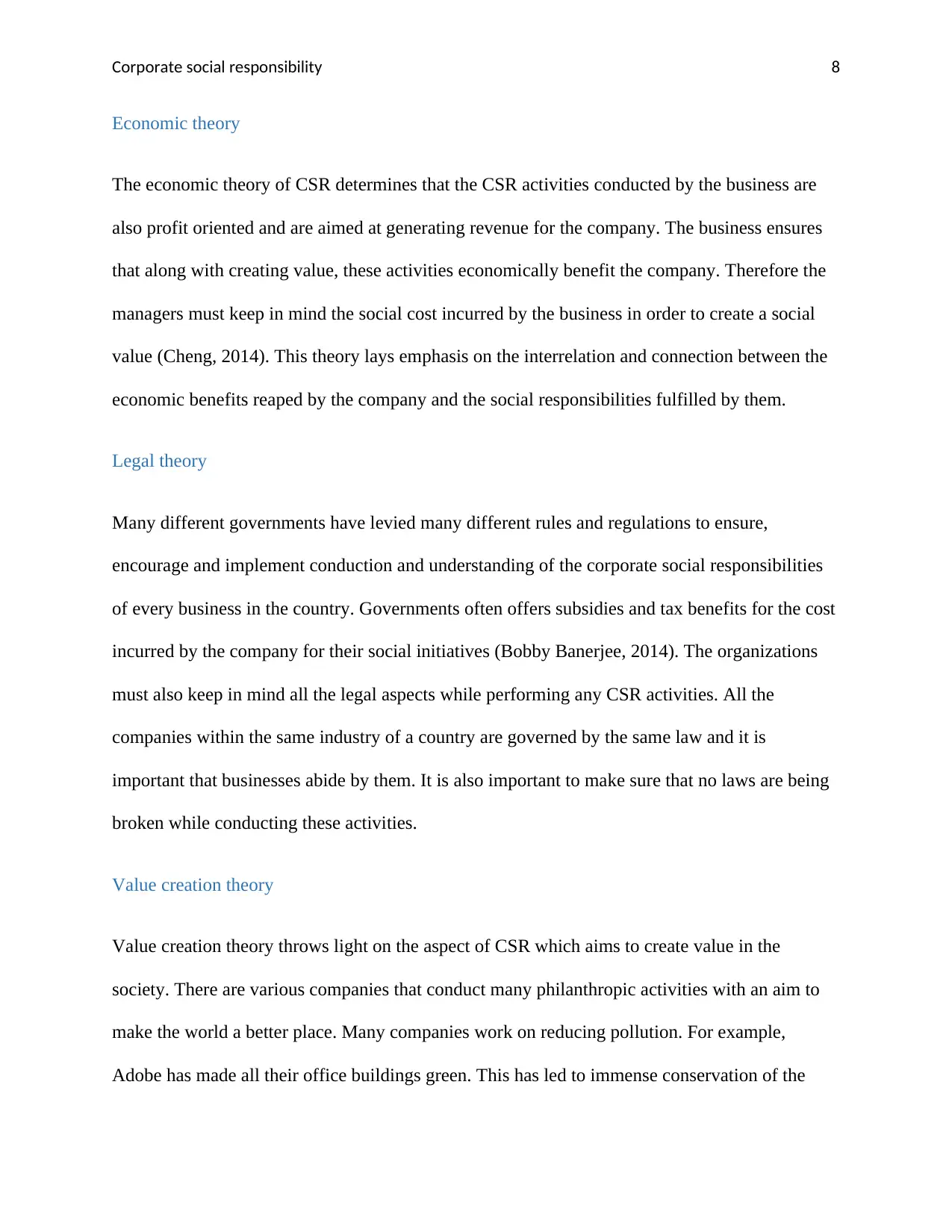
Corporate social responsibility 8
Economic theory
The economic theory of CSR determines that the CSR activities conducted by the business are
also profit oriented and are aimed at generating revenue for the company. The business ensures
that along with creating value, these activities economically benefit the company. Therefore the
managers must keep in mind the social cost incurred by the business in order to create a social
value (Cheng, 2014). This theory lays emphasis on the interrelation and connection between the
economic benefits reaped by the company and the social responsibilities fulfilled by them.
Legal theory
Many different governments have levied many different rules and regulations to ensure,
encourage and implement conduction and understanding of the corporate social responsibilities
of every business in the country. Governments often offers subsidies and tax benefits for the cost
incurred by the company for their social initiatives (Bobby Banerjee, 2014). The organizations
must also keep in mind all the legal aspects while performing any CSR activities. All the
companies within the same industry of a country are governed by the same law and it is
important that businesses abide by them. It is also important to make sure that no laws are being
broken while conducting these activities.
Value creation theory
Value creation theory throws light on the aspect of CSR which aims to create value in the
society. There are various companies that conduct many philanthropic activities with an aim to
make the world a better place. Many companies work on reducing pollution. For example,
Adobe has made all their office buildings green. This has led to immense conservation of the
Economic theory
The economic theory of CSR determines that the CSR activities conducted by the business are
also profit oriented and are aimed at generating revenue for the company. The business ensures
that along with creating value, these activities economically benefit the company. Therefore the
managers must keep in mind the social cost incurred by the business in order to create a social
value (Cheng, 2014). This theory lays emphasis on the interrelation and connection between the
economic benefits reaped by the company and the social responsibilities fulfilled by them.
Legal theory
Many different governments have levied many different rules and regulations to ensure,
encourage and implement conduction and understanding of the corporate social responsibilities
of every business in the country. Governments often offers subsidies and tax benefits for the cost
incurred by the company for their social initiatives (Bobby Banerjee, 2014). The organizations
must also keep in mind all the legal aspects while performing any CSR activities. All the
companies within the same industry of a country are governed by the same law and it is
important that businesses abide by them. It is also important to make sure that no laws are being
broken while conducting these activities.
Value creation theory
Value creation theory throws light on the aspect of CSR which aims to create value in the
society. There are various companies that conduct many philanthropic activities with an aim to
make the world a better place. Many companies work on reducing pollution. For example,
Adobe has made all their office buildings green. This has led to immense conservation of the
⊘ This is a preview!⊘
Do you want full access?
Subscribe today to unlock all pages.

Trusted by 1+ million students worldwide
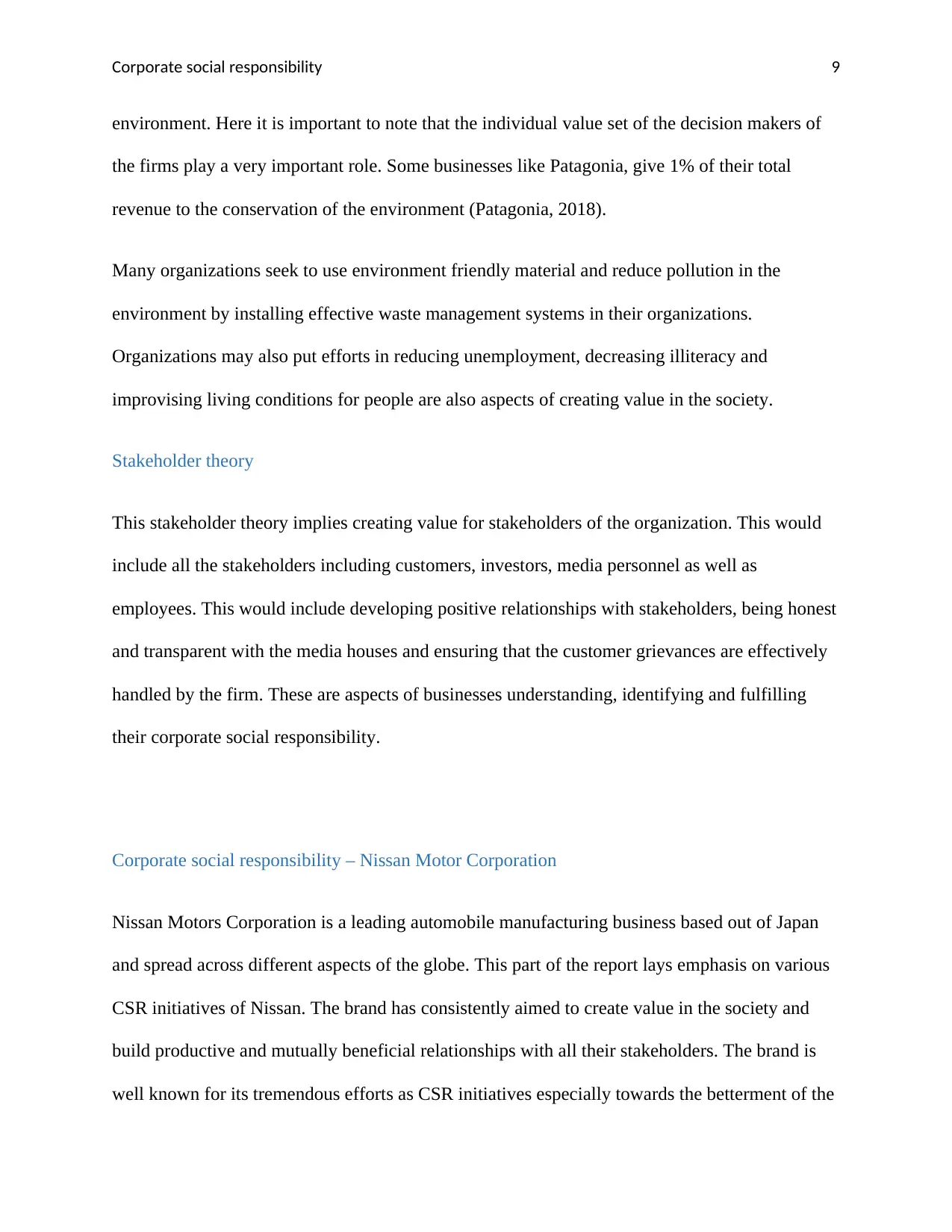
Corporate social responsibility 9
environment. Here it is important to note that the individual value set of the decision makers of
the firms play a very important role. Some businesses like Patagonia, give 1% of their total
revenue to the conservation of the environment (Patagonia, 2018).
Many organizations seek to use environment friendly material and reduce pollution in the
environment by installing effective waste management systems in their organizations.
Organizations may also put efforts in reducing unemployment, decreasing illiteracy and
improvising living conditions for people are also aspects of creating value in the society.
Stakeholder theory
This stakeholder theory implies creating value for stakeholders of the organization. This would
include all the stakeholders including customers, investors, media personnel as well as
employees. This would include developing positive relationships with stakeholders, being honest
and transparent with the media houses and ensuring that the customer grievances are effectively
handled by the firm. These are aspects of businesses understanding, identifying and fulfilling
their corporate social responsibility.
Corporate social responsibility – Nissan Motor Corporation
Nissan Motors Corporation is a leading automobile manufacturing business based out of Japan
and spread across different aspects of the globe. This part of the report lays emphasis on various
CSR initiatives of Nissan. The brand has consistently aimed to create value in the society and
build productive and mutually beneficial relationships with all their stakeholders. The brand is
well known for its tremendous efforts as CSR initiatives especially towards the betterment of the
environment. Here it is important to note that the individual value set of the decision makers of
the firms play a very important role. Some businesses like Patagonia, give 1% of their total
revenue to the conservation of the environment (Patagonia, 2018).
Many organizations seek to use environment friendly material and reduce pollution in the
environment by installing effective waste management systems in their organizations.
Organizations may also put efforts in reducing unemployment, decreasing illiteracy and
improvising living conditions for people are also aspects of creating value in the society.
Stakeholder theory
This stakeholder theory implies creating value for stakeholders of the organization. This would
include all the stakeholders including customers, investors, media personnel as well as
employees. This would include developing positive relationships with stakeholders, being honest
and transparent with the media houses and ensuring that the customer grievances are effectively
handled by the firm. These are aspects of businesses understanding, identifying and fulfilling
their corporate social responsibility.
Corporate social responsibility – Nissan Motor Corporation
Nissan Motors Corporation is a leading automobile manufacturing business based out of Japan
and spread across different aspects of the globe. This part of the report lays emphasis on various
CSR initiatives of Nissan. The brand has consistently aimed to create value in the society and
build productive and mutually beneficial relationships with all their stakeholders. The brand is
well known for its tremendous efforts as CSR initiatives especially towards the betterment of the
Paraphrase This Document
Need a fresh take? Get an instant paraphrase of this document with our AI Paraphraser
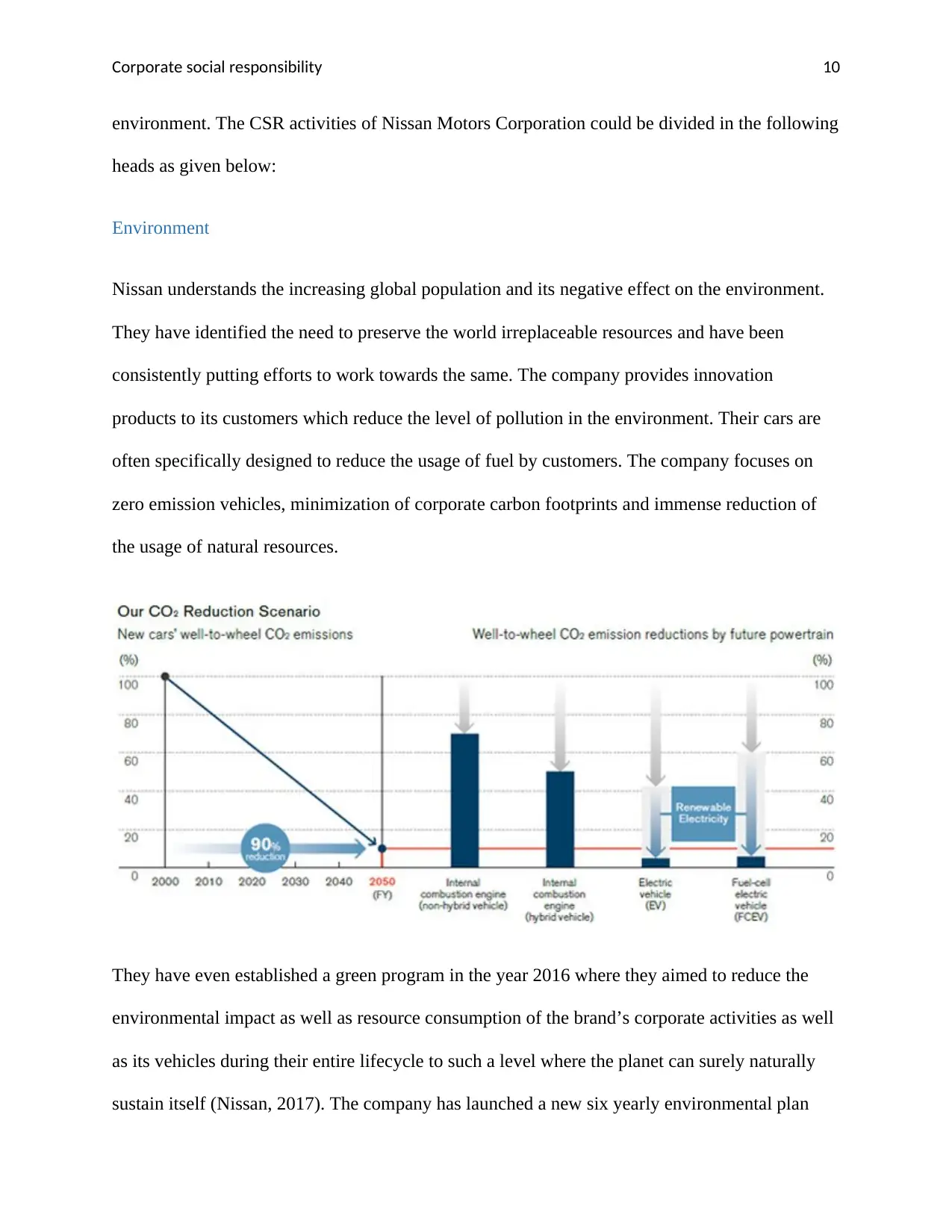
Corporate social responsibility 10
environment. The CSR activities of Nissan Motors Corporation could be divided in the following
heads as given below:
Environment
Nissan understands the increasing global population and its negative effect on the environment.
They have identified the need to preserve the world irreplaceable resources and have been
consistently putting efforts to work towards the same. The company provides innovation
products to its customers which reduce the level of pollution in the environment. Their cars are
often specifically designed to reduce the usage of fuel by customers. The company focuses on
zero emission vehicles, minimization of corporate carbon footprints and immense reduction of
the usage of natural resources.
They have even established a green program in the year 2016 where they aimed to reduce the
environmental impact as well as resource consumption of the brand’s corporate activities as well
as its vehicles during their entire lifecycle to such a level where the planet can surely naturally
sustain itself (Nissan, 2017). The company has launched a new six yearly environmental plan
environment. The CSR activities of Nissan Motors Corporation could be divided in the following
heads as given below:
Environment
Nissan understands the increasing global population and its negative effect on the environment.
They have identified the need to preserve the world irreplaceable resources and have been
consistently putting efforts to work towards the same. The company provides innovation
products to its customers which reduce the level of pollution in the environment. Their cars are
often specifically designed to reduce the usage of fuel by customers. The company focuses on
zero emission vehicles, minimization of corporate carbon footprints and immense reduction of
the usage of natural resources.
They have even established a green program in the year 2016 where they aimed to reduce the
environmental impact as well as resource consumption of the brand’s corporate activities as well
as its vehicles during their entire lifecycle to such a level where the planet can surely naturally
sustain itself (Nissan, 2017). The company has launched a new six yearly environmental plan
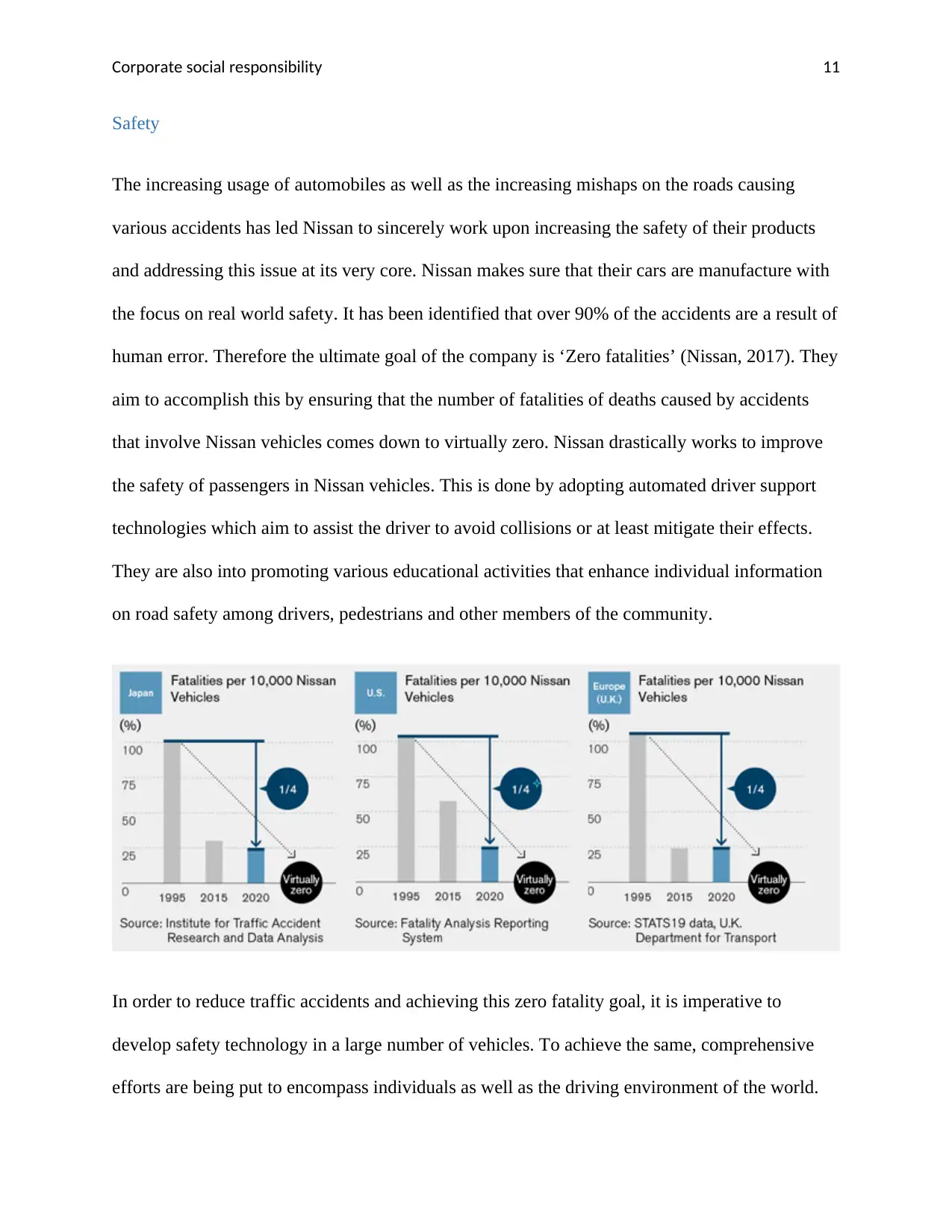
Corporate social responsibility 11
Safety
The increasing usage of automobiles as well as the increasing mishaps on the roads causing
various accidents has led Nissan to sincerely work upon increasing the safety of their products
and addressing this issue at its very core. Nissan makes sure that their cars are manufacture with
the focus on real world safety. It has been identified that over 90% of the accidents are a result of
human error. Therefore the ultimate goal of the company is ‘Zero fatalities’ (Nissan, 2017). They
aim to accomplish this by ensuring that the number of fatalities of deaths caused by accidents
that involve Nissan vehicles comes down to virtually zero. Nissan drastically works to improve
the safety of passengers in Nissan vehicles. This is done by adopting automated driver support
technologies which aim to assist the driver to avoid collisions or at least mitigate their effects.
They are also into promoting various educational activities that enhance individual information
on road safety among drivers, pedestrians and other members of the community.
In order to reduce traffic accidents and achieving this zero fatality goal, it is imperative to
develop safety technology in a large number of vehicles. To achieve the same, comprehensive
efforts are being put to encompass individuals as well as the driving environment of the world.
Safety
The increasing usage of automobiles as well as the increasing mishaps on the roads causing
various accidents has led Nissan to sincerely work upon increasing the safety of their products
and addressing this issue at its very core. Nissan makes sure that their cars are manufacture with
the focus on real world safety. It has been identified that over 90% of the accidents are a result of
human error. Therefore the ultimate goal of the company is ‘Zero fatalities’ (Nissan, 2017). They
aim to accomplish this by ensuring that the number of fatalities of deaths caused by accidents
that involve Nissan vehicles comes down to virtually zero. Nissan drastically works to improve
the safety of passengers in Nissan vehicles. This is done by adopting automated driver support
technologies which aim to assist the driver to avoid collisions or at least mitigate their effects.
They are also into promoting various educational activities that enhance individual information
on road safety among drivers, pedestrians and other members of the community.
In order to reduce traffic accidents and achieving this zero fatality goal, it is imperative to
develop safety technology in a large number of vehicles. To achieve the same, comprehensive
efforts are being put to encompass individuals as well as the driving environment of the world.
⊘ This is a preview!⊘
Do you want full access?
Subscribe today to unlock all pages.

Trusted by 1+ million students worldwide
1 out of 18
Related Documents
Your All-in-One AI-Powered Toolkit for Academic Success.
+13062052269
info@desklib.com
Available 24*7 on WhatsApp / Email
![[object Object]](/_next/static/media/star-bottom.7253800d.svg)
Unlock your academic potential
Copyright © 2020–2025 A2Z Services. All Rights Reserved. Developed and managed by ZUCOL.





